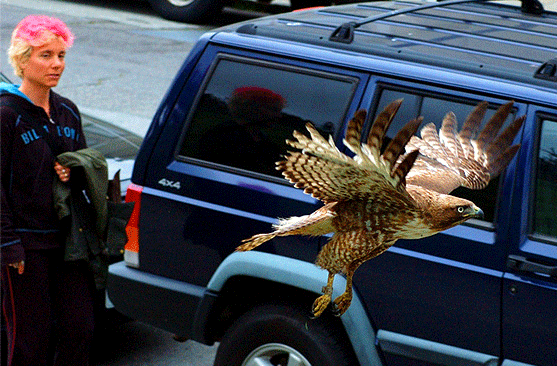FIRST PERSON | Walter Kitundu
For seven months I chronicled the life of Patch, a red-tailed hawk who lives in and around Alta Plaza Park, capturing her transition from immature bird to adult.
I had heard of New York’s Pale Male, a redtail that lives in Central Park and famously built a nest atop a Fifth Avenue apartment building. After concluding that this San Francisco redtail used Alta Plaza Park as a home base, I decided the bird deserved a name. Many redtails have a light spot on the crown of their heads. This hawk’s spot was quite prominent, so I dubbed her “Patch.”
The name still works if someday she turns out to be a he. It is difficult to accurately determine the sex of red-tailed hawks. I decided Patch was female because she is a large bird, and female hawks are generally larger than males.
While I photographed her, between January and July of 2006, she adapted quickly to the park and skillfully navigated the people, dogs, construction and other wildlife in the environment. She was hard to miss, with a broad four-foot wingspan and her penchant for perching on the streetlights. Redtails can be up to two feet tall and weigh almost four pounds. By comparison, the average pigeon weighs about a pound.
Patch’s diet consisted mainly of the gophers and other rodents populating the terraced edges of Alta Plaza. She proved quite an opportunist, however, and also ate pigeons, blackbirds, caterpillars and even the occasional worm.
Her hunting techniques included scanning from a perch, kiting in the high winds over the park, flying low and fast over rooftops and even walking on the ground to seek out insects. She once flew in from over a quarter of a mile away in a direct dive to pluck an unsuspecting gopher from under the shadow of a row of trees near the west side of the park. Her success rate hovered around one out of five attempts. Some days she never seemed to miss, and other days she flew frantically around the park and desperately low trying to find anything that resembled a meal.
One of her favorite perches was the cross on the church opposite the south stairs. From there she had a commanding view of the park and its surroundings.
Patch began molting and almost completed her transition into adulthood before starting to take exploratory trips out of the park. Today she has her full adult plumage, with striking dark brown feathers, a bright red tail and a rusty orange underside. She is still an occasional visitor to Alta Plaza.
During the months I was photographing her, she was in the park almost every day. I was honored to have this sort of relationship with a wild hawk. A level of trust and familiarity developed, and she often landed on the ground near me — sometimes as close as five feet away. She allowed me to sit within 10 feet while she ate many of her meals.
Redtails are the most common hawk in this area. They are extremely adaptable and can be found throughout the city — especially in Golden Gate Park and the Presidio — though it is rare to find a bird as idiosyncratic and bold as Patch.
Across the bay at the place where Patch was banded, on Hawk Hill in the Marin headlands, the Golden Gate Raptor Observatory sees hundreds of red-tailed hawks during the fall migration.
It is wonderful to know these birds are living in our midst. And it has been heartwarming to follow Patch, and to watch her react, adapt, grow and survive in these four square blocks in the center of the city.
VIEW: Walter Kitundu’s photographs of Patch
UPDATE: After residents near Alta Plaza Park repeatedly called the police to report a suspicious man with a camera loitering in the park, Walter Kitundu posted a flyer assuring concerned residents he was merely a harmless photographer.
But Kitundu is also a sound artist, an instrument builder and a composer, among many other creative pursuits. And now he’s something else: In 2008 he was named a MacArthur Fellow — the “genius award,” with a no-strings-attached $500,000 grant, from the MacArthur Foundation.
Kitundu, 35, lives alone in a studio apartment in the Western Addition. “I’ve been making my living thinking up crazy instruments,” he says. “I don’t feel the need to make any enormous sweeping changes.”
Filed under: First Person









